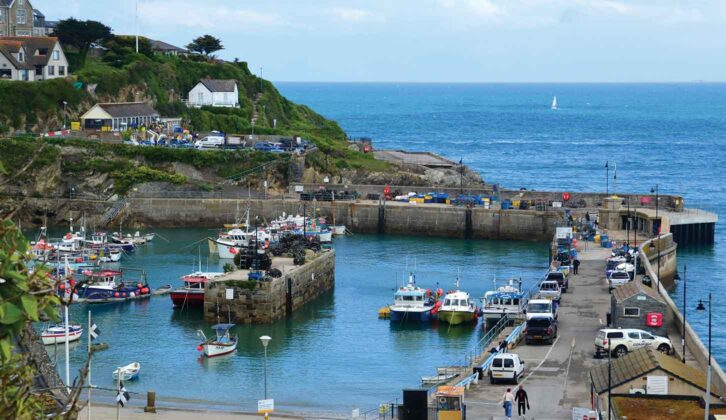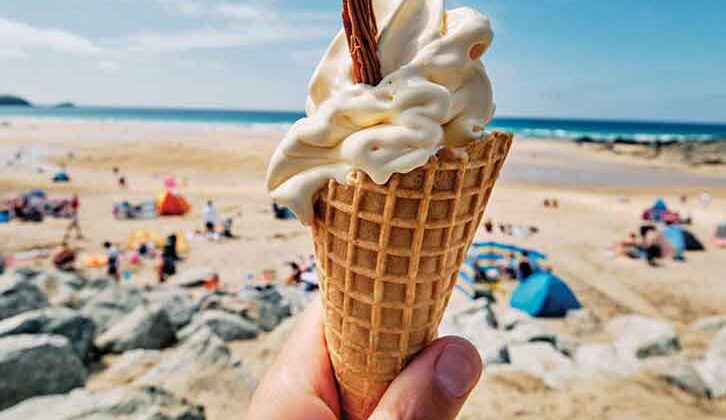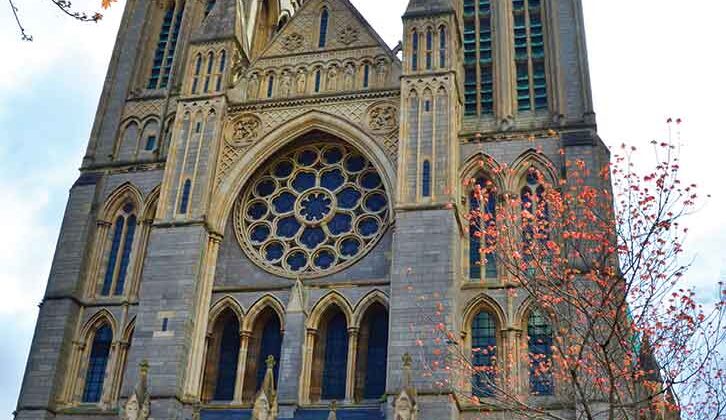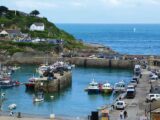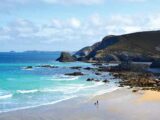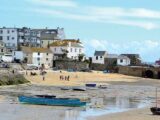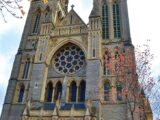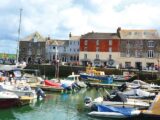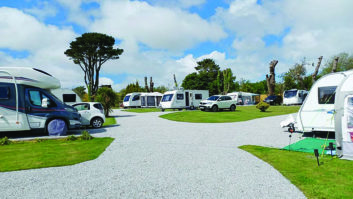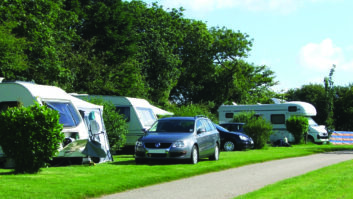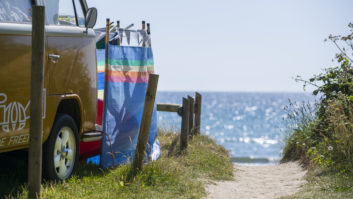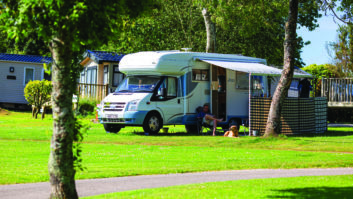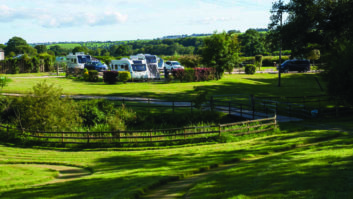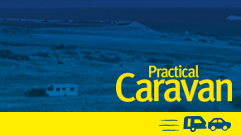Whichever time of the year you choose to visit Cornwall, you’ll always be able to enjoy the beautiful scenery. But in summer it has a justified reputation for being busy, so we chose to tour in May, hoping that it would be quieter, with spring weather.
We made two overnight stops en route, before finally arriving at the Caravan and Motorhome Club site at Treamble Valley, near Newquay. This pretty campsite, set in a wooded valley, is laid out in individual pitching zones, giving a secluded feel. There are plenty of picturesque campsites to choose from in the region though, as our best caravan park in Cornwall guide highlights.
I was pleased to see there were plenty of pitches available when we turned up at Treamble and we took one next to our friends Helen and Roy, who had arrived there the day before.
Hugging the coast
On our first day, we parked with our friends in Newquay, in a Cornwall Council car park that is free of charge until 17 May – another bonus of visiting early. Nearby was a view of the harbour and Newquay’s fabulous beaches, Towan, Great Western and Tolcarne. The most famous, Fistral, was a short walk away. This long stretch of shoreline has some of the best waves in the world for surfing.
Unfortunately, just as we arrived, the rain came down, so we sought shelter at Fistral Beach Bar for coffee. The weather didn’t stop keen surfers riding the waves!

We moved on to Perranporth, where Helen had seen a café the day before that offered converted beach huts for outdoor dining. But when we arrived, we found a notice on the door – ‘Closed due to rain’. We did find an ice cream parlour, but we were already wet and cold, so instead, we bought pasties from a shop and ate them in the car. Perhaps a downside of touring earlier in the season?
After that rainwashed day, we got up next morning to find blue skies and bright sun. We drove to Perranporth to see the vast expanse of sandy beach in better weather conditions – although there was still a cold wind. We went on to St Agnes, and down to the achingly beautiful Trevaunance Cove (check out our guide to the best campsites with glorious views if you love taking in stunning scenes too).
Historic harbour
This horseshoe-shaped bay surrounded by cliffs has a surf shop and a few eateries, only one of which was open at the time of our visit. You can still see the remains of the old harbour, once used for shipping tin and copper ore to the smelters.
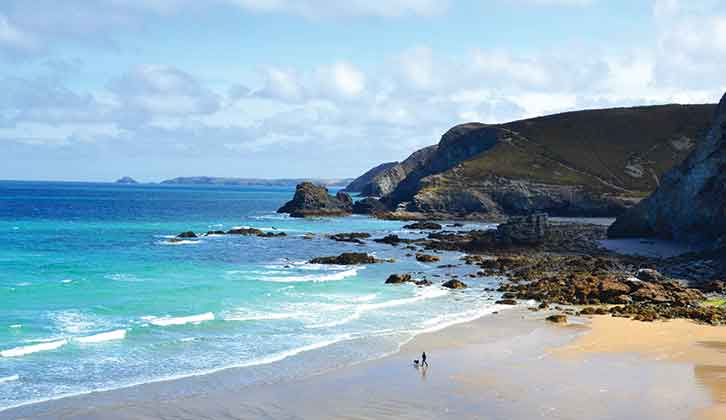
Five harbours have been built over the years here, and each one has been destroyed by violent storms!
Take-away service was available at the Breakers Beach Café, so we relaxed in the sunshine in the Jubilee Garden, overlooking the cove, to enjoy another meal of pasties.
The St Agnes mining district is a Cornish Mining World Heritage site. The iconic, and much photographed, Wheal Coates engine house, perched on cliffs overlooking the sea, is a short drive away from St Agnes, or can be reached by walking along the coastal path. We were no exception, taking photos from every conceivable angle.
The Towanroath engine house, to give it the official name, had a steam engine which was used to pump water out of a new shaft, 185m below sea level. The remains of the structure date back to 1872, although the earliest records are from 1692 and it is thought that digging for ore began some time in the Middle Ages. The mine closed in 1914 and is now run by the National Trust.
Coastal views
Moving on, we briefly visited the charming fishing village of Portreath, which has a sandy beach with headlands on both sides. These days, its narrow harbour is little used, apart from the occasional fishing boat, but in the past, this was a busy port importing coal and exporting copper.
The main attractions now are the beach, the harbour, surfing and walks along the coastal path. The village itself is largely undeveloped, with a few shops and cafés, and some holiday accommodation.
Leaving Portreath, we turned off the road at a car park sign for North Cliffs, where we discovered a gorgeous view of the coastline. There’s a wheelchair-friendly footpath here, maintained by the National Trust.
Further along the road, we decided to head for Godrevy. We didn’t know what the attraction might be, but thought we’d take a look. We weren’t disappointed, either.
Managed by the National Trust, this is a stunning part of Cornwall Area of Outstanding Natural Beauty. Facing the Atlantic, it’s great for surfing and for walking on the promontory. Offshore is Godrevy Island, where there is a famous lighthouse, said to have inspired Virginia Woolf’s novel, To the Lighthouse.
For us, the icing on the cake of a brilliant day out was seeing seals on the beach below.
Going to St Ives
Next day, we drove to St Ives, where we stopped at another free Cornwall Council car park. Opposite was a café/bar offering great views of this delightful town.
Lured in by this prospect, we drank our coffee while savouring the view – and the glorious weather. Opposite the café, we saw a fleet of buses, which for £1 per person, would drop us in the centre of town. The driver told us it was a new scheme, aiming to minimise traffic in the narrow streets.
St Ives is a very picturesque fishing harbour and seaside town, with cobbled streets, independent shops, galleries and gorgeous beaches, as well as Tate St Ives, and the former studios of sculptor Barbara Hepworth and potter Bernard Leach.
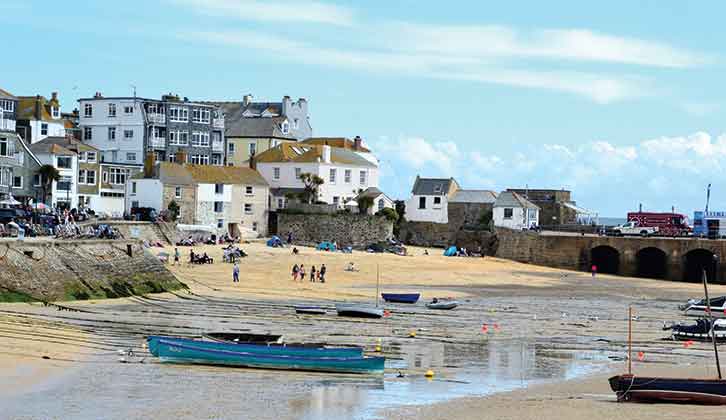
St Ives seems to have it all, so no wonder it gets busy in the high season. We strolled around, window shopping, until we arrived at The Wharf, where most of the excellent eateries are to be found.
We ate lunch at The Beachcomber (now sadly closed), bathed in sunlight and with great views across the harbour.
Next day, we decided that a quieter time was called for after two days of jaunting about, so we drove to nearby Truro, where we parked at the top of the multistorey car park, with a fine view of the cathedral.
Built between 1880 and 1910 in Gothic Revival style, this is one of only a trio of cathedrals in the UK to have three spires.
Castle and coastline
Sadly, the weather proved unreliable and in a deluge of rain, we drove to Falmouth, where we parked close to the harbour. Fortunately, by the time we arrived, the sun had come out again, and we found several promising cafés and restaurants. We stopped for lunch at The Shed, and enjoyed wholesome BLTs.
Just around the corner is the National Maritime Museum Cornwall, which looked interesting but was closed at the time of our visit. We strolled around and admired the leisure craft in the harbour, instead.
Later, we walked up the hill towards Pendennis Castle, a fortification built on the headland during Henry VIII’s reign and surrounded by a huge grassy bank.
Back at the car, we drove around the Pendennis Peninsula before returning to the site. So much for a quiet day out!
The following morning we decided to drive to Penzance, but as we stepped out of the car, the rain started. We’d already put off exploring to do some shopping, and had thought the weather was improving.
We paused for lunch at Hellys Deli Bar Café, and luckily, the sun came out for the rest of our day. We drove on to the pretty seaside town of Newlyn, trying to spot somewhere to park and finding ourselves going down lots of narrow streets lined with charming old houses.
It was a great sight for the passengers but not so for the driver, who had her eyes glued to the road! Emerging by a car park, we at last spotted a space.
Newlyn has a shingle beach and views over to Penzance and St Michael’s Mount. It is probably best known for the busy harbour, where fishing boats mingle with leisure craft. It’s also famous as the home of the Newlyn School, a colony of artists who flocked there from the 1880s to the early 20th century, to paint en plein air.
Their main subjects were the fishermen and their boats, and the women waiting on shore for their return from hazardous trips.
Navigating the narrows
We continued to the postcard-pretty village of Mousehole. Although I had driven these narrow streets years ago, I was now pleased to see a car park on the edge of the village.
It was just a short stroll to the harbour, where a wide variety of craft were moored. I can never resist reading wall plaques and we found two fine examples in Mousehole.
One proclaims that Squire Jenkyn Keigwin died defending his house against the Spaniards in 1595. While the rest of Mousehole was burned to the ground, his 14th-century house survived and is now the oldest in Mousehole. The other plaque, at The Ship Inn, is even more poignant.
It commemorates the Penlee Lifeboat Disaster of 1981, when the crew of the RNLI Solomon Browne, including the landlord of The Ship, Charles Greenhaugh, lost their lives during an attempted rescue mission in hurricane force winds.
Mousehole’s harbour illuminations are switched off on 19 December every year in memory of those brave seafarers.
Remote landscape
For a change we decided to drive north, stopping off at the enormous sandy beach of Watergate Bay. Continuing onwards, we paused at a sign indicating Carnewas at Bedruthan, a National Trust property where visitors can observe the spectacular Bedruthan Steps. This dramatic coastline overlooks huge rock stacks, or steps.
We stopped for lunch there, to enjoy the views, then moved on to the wild, remote landscape of Trevose Head, an imposing headland jutting out into the Atlantic.
There’s also a massive sinkhole here, known somewhat unimaginatively as the Round Hole, caused by a cave collapse.
Our final stop was at Padstow, still a working fishing port despite also being a popular tourist destination. It was late in the day, so we grabbed some refreshments and walked along the Camel River towards the estuary. There are massive sandbank at low tide, which the ferry between Rock and Padstow manages to navigate.
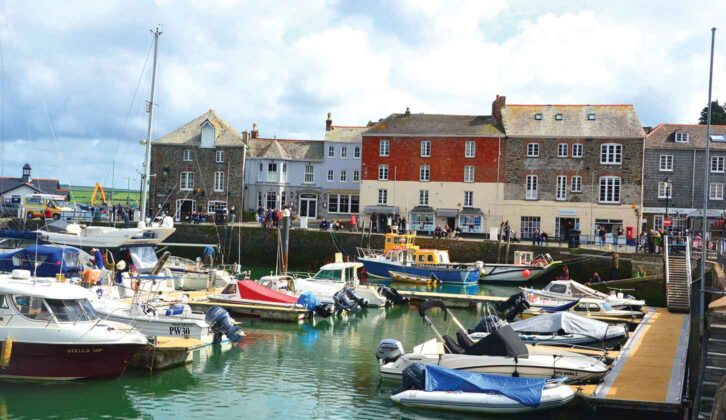
Exploring the biodomes
The forecast was bad for the next day, so we booked an afternoon visit to the Eden Project. We spent a pleasant morning in Mevagissey, a traditional fishing village with gift shops, bars, cafés and galleries.
Probably one of Cornwall’s best-known visitor attractions, with its unmistakable biodomes, the Eden Project was started in an old clay pit in 1995, eventually opening its doors to the public in March 2001.
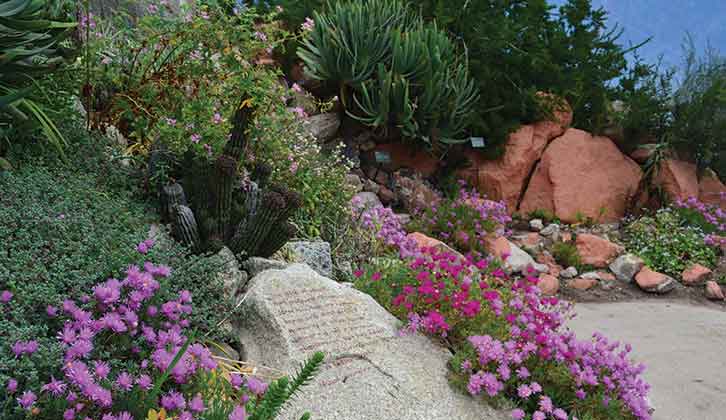
We headed for the tropical biodome, where bananas, rubber, coffee and giant bamboo grow. Following the gently rising path through the biodome, we reached the top, at which point the rain poured down on the roof, providing an all too realistic rainforest effect! A dramatic waterfall enters the biodome there, as well.
All too soon, it was time for us to head for home, but we thoroughly enjoyed our visit to this popular part of the world, despite the vagaries of the British weather.
Neighbouring Devon is another beautiful part of the country to head to – take a look at our best caravan park in Devon guide if you’re after a site to stay at in the region.
Where we stayed
Treamble Valley Caravan and Motorhome Club Site
Rose, Truro TR4 9PR, caravanclub.co.uk
- Open: March to November
- Pitches: 132
- Price: From £13
Treamble Valley is set in 36 acres of woodland, offering sea views, fantastic opportunities to observe the local wildlife, and spectacular sunsets. It is also ideally located for exploring
the surrounding area and visiting the nearby beaches.
When to go
We went in May, but we were rather unlucky with the weather. For the sunniest conditions, July and August are of course best, but the summer months are extremely busy in Cornwall.
Way to go
From Lancashire, we took the M6, M6 toll, M42 (for an overnight stop), then M5 to Cheddar (overnight stop), resumed the M5, then the A30 and A392, followed by the A3075 until the right turn sign for Rejerrah, where we continued to the end of the road (narrow in places).
Find out more
- Visit Cornwall
- Visit Newquay
- St Ives Tourism
- Wheal Coates and Carnewas at Bedruthan
- The Eden Project
- Mousehole
Our outfit
We towed our 2017 Knaus Starclass 560 with our 2017 Volvo XC60 AWD
If you’ve enjoyed reading this article, why not get the latest news, reviews and features delivered direct to your door or inbox every month. Take advantage of our brilliant Practical Caravan magazine SUBSCRIBERS’ OFFER and SIGN UP TO OUR NEWSLETTER for regular weekly updates on all things caravan related.
